
Understanding the role of EIN in 2290 truck tax reporting.
Identification.
It’s a critical element of your 2290 filing regime, your information returns with the IRS.
While individuals are required to report their social security numbers (SSNs), business entities are required to report employer identification numbers (EINs).
If you’ve recently received your new EIN from the IRS, and your 2290 returns keep getting rejected due to “unknown EIN” or “invalid EIN” citations, then there’s a good chance that either your EIN was reported incorrectly. Or your EIN doesn’t exist in the IRS records.
So, what now?
Should you get a new EIN to file your 2290 truck tax forms?
Let’s find out.
Using EINs For Reporting 2290 Tax Information
Trucking companies, truck businesses, and owner-operator truckers need to prepare and file their 2290 forms, and report the employer identification number (EIN) to indicate unique identification.
Since 1998, the IRS has been pretty stern about retaining only the employer identification number as the base of identification for HVUT 2290 form filings.
Prior to that, social security numbers were also accepted. But this isn’t the case anymore.
The IRS does not accept social security numbers as identification for HVUT reporting.
Getting A New EIN For Your Trucking Business
If you own a trucking company, you’ve likely been assigned an employer identification number (EIN) by the social security administration (SSA) or the IRS.
However, if the name of your business has changed over the years or if you have wound up the business, your old EIN can no longer be used for your current 2290 filings.
If the ownership of your business has changed or if the business was incorporated recently, you need to file for a new Employer Identification Number (EIN) by filing an SS-4 form with the IRS.
Unlike a social security number, EIN is assigned to entities, trusts, and businesses. Not individuals.
The new EIN can be used to file your 2290 returns with the IRS.
Why The IRS Rejects A New EIN Reported On HVUT Form 2290
It’s essential to note that a new EIN request takes about 2 weeks to be processed by the IRS.
Additional 2 weeks time to establish the newly generated EIN/legal name combination in the IRS records.
So, if you’ve recently received your employer identification number (EIN) and you’ve tried to file your 2290 returns with the IRS, your filing requests could be delayed or rejected.
This is because the IRS database doesn’t have the new details added to its database yet.
As and when the new details are added, your EIN and legal name reports will be accepted by the IRS.
To reiterate, you may need to wait for about 2 weeks before you file your IRS 2290 forms with the new EIN.
Do You Need New EIN For Filing 2290 Truck Tax?
Not necessarily.
You don’t need a new EIN to file your 2290 returns if you have valid EIN/name information.
New or old, every business needs to hold valid and functioning EIN and legal name information (in accordance with the IRS records) to get the IRS to accept your 2290 filings.
If you’re reporting expired EIN credentials or incorrect EIN/name combinations, the IRS will likely reject your 2290 forms.
The general rule here is that you need to verify your EIN and name combinations before you report it on your 2290 forms (or any IRS form for that matter) to avoid getting your filings rejected.
Validate your EIN/name information with the IRS TIN Matching system online and report the verified EIN on Form 2290.
If you’re here, and you’re looking for information to report a valid EIN on your 2290 forms, then there’s a good chance that you care about your 2290 filings.
HVUT 2290 reporting regime requires you to gather a variety of information, including but not limited to:
- Employer identification number (EIN)
- Business name
- Vehicle identification number (VIN)
- Total number of vehicles
- Vehicle category
- Tax suspension details of vehicles
- Month of first use
- Mileage use limit
When you’re dealing with this kind of information, it’s important to choose your eFile providers wisely.
In the wrong hands, your business information can be fraudulently used, which can result in reputational loss, legal trouble, and even financial liabilities.
There are many scammy websites out there that claim to be “legitimate” eFile providers, but they could be just bad actors waiting to steal your data.
eFile your 2290 returns with an IRS-authorized eFile provider like EZ2290.
How to check if we’re really authorized by the IRS?
The IRS publishes a list of authorized eFile providers every year. You can verify it for yourself on the official IRS portal here.
EZ2290 offers:
- Easy 3-step eFile experiences
- Encrypted form completion
- Secure e-file transmission
- Automatic tax calculations
- Bulk 2290 eFile solutions
- Free VIN corrections
- Free re-filing for rejected returns
- 24×7 priority 2290 support
No data compromise.
No paperwork.
No mess.
Just seamless e-filing.
Get Started For Free & eFile Form 2290
Other Useful Posts From Ez2290 Blog
- Understanding Vehicle Category To File Form 2290 Online
- 4 Mistakes You’ve Got To Avoid On Your 2290 Forms
- 2290 Rejection Reasons – Top Reasons The IRS Rejects HVUT Form 2290
- IRS 2290 HVUT Payments: Various Ways You Can Pay Your 2290 Tax Online With EZ2290
- Name Error In IRS Form 2290: How To Do Name Correction On HVUT Form 2290?







